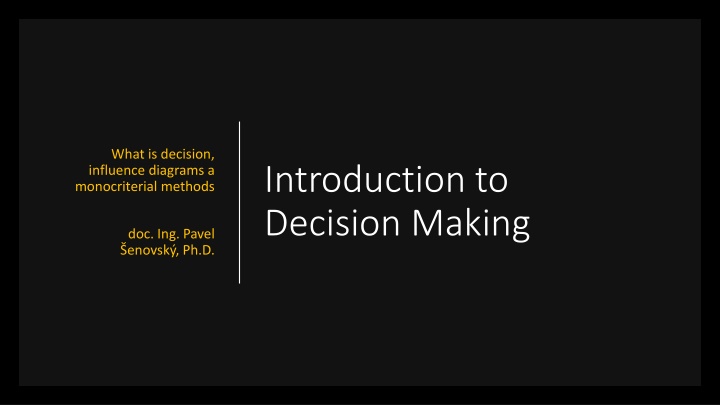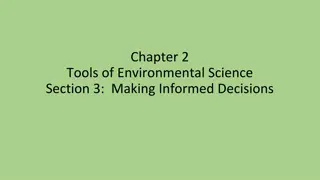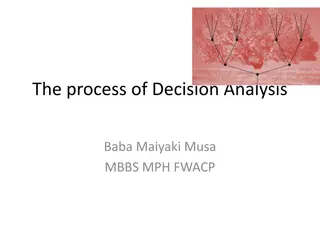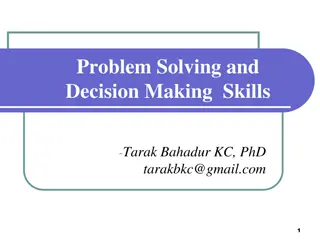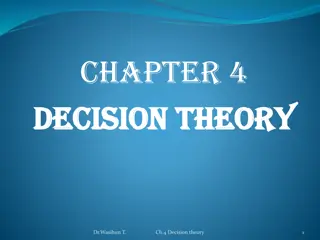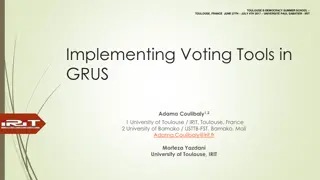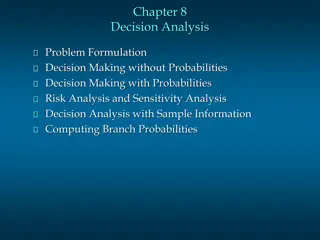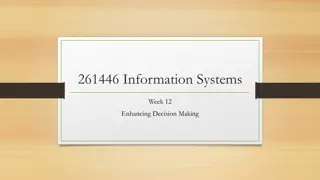Introduction to Decision Making
Decision making involves conscious or unconscious choices, with various factors influencing the outcome. Understanding decision context, hierarchy, and goals is crucial for effective decision-making processes. Influence diagrams and monocriterial methods play roles in decision analysis.
Download Presentation

Please find below an Image/Link to download the presentation.
The content on the website is provided AS IS for your information and personal use only. It may not be sold, licensed, or shared on other websites without obtaining consent from the author.If you encounter any issues during the download, it is possible that the publisher has removed the file from their server.
You are allowed to download the files provided on this website for personal or commercial use, subject to the condition that they are used lawfully. All files are the property of their respective owners.
The content on the website is provided AS IS for your information and personal use only. It may not be sold, licensed, or shared on other websites without obtaining consent from the author.
E N D
Presentation Transcript
What is decision, influence diagrams a monocriterial methods Introduction to Decision Making doc. Ing. Pavel enovsk , Ph.D.
Decision Decision is conscious or unconscious choice Choosing presumes existence of the variants leading to goal, but different in utility and costs attached to it Decision making <- optimization problem The problem Variants of the solution are not always known Distinguishing between them is not always easy Decision goal is not always easily specified in measurable manner
Decision situation Difference in predictability of decision result Deterministic known results, without probabilistic elements Stochastic More common in real life The result of the decision is characterized by utility value and probability of it happening Necessity to evaluate whole fan of probability (so more complex to evaluate)
Hierarchy and structure of the decision By the decision we aim to fulfill a goal or goals The goals may be achievable by various methods and may Support each other Or work against each other (in extreme be mutually exclusive) Each decision situation has its goal hierarchy. Consider maximizing safety of car traffic What goals do you have? Who has the ability to achieve them?
Goal hierarchy of car traffic safety Who decides (point of view)? Driver? Car manufacturer? Ministry of transportation?
Decision context Where exactly in the goal hierarchy are we and what tools do we have available In context of the business decision making in organizations What groups of workers/managers should be part of decision process What are their respective goals in the decision situations Who has the knowledge in problem domain? The manager formulates the problem, puts together team allocates resources Uses the results of the analysis to make a decision
Interpret results Statement of the problem Decision phases Analysis itself is not always success Sometimes it is necessary to do more than one iteration Each iteration contributes to knowledge about the problem Success is not guaranteed More than one method may be needed Getting to know the problem Perform analysis Identification of the criteria Choose method Gathering information about the variants
Methods What exactly should be the result of method usage? Better understanding of the problem? Or finding optimal solution to the problem choosing optimal variant of solution? If solution needs to be found are we optimizing against single criterion or multiple criteria? If multiple criteria how do we establesh respactive weights of the criteria There is no single universally usable solve it all method Choosing the right method is first step to problem solution
Beginning of the decision making Tools to better understand the situation and its properties - methods Brainstorming and mind maps (both separate lecture) Also well known methods like SWOT analysis or Ishikawa diagram Many other methods These method do not usually present solution of the problem!
Influence diagrams Easy to understand diagrams describing influence of various factors on decision making constructors:
Influence diagram example
Example 2 + remarks Influence of various factors on obesity http://www.shiftn.com/obesity/Full-Map.html Not all type of nodes need to be used (depending on your needs) Proper presentation of the results can help Clarify your point of view Better communicate problem And to influence people
Presenting the analysis results Difficult decision problems require participation of knowledge-wise broad teams Members of the team are not persons making the decision The results of the analysis must be presented In form understandable for persons not skilled in decision problem domain Must be short Results must be defendable (every step taken)
Decision trees Monocriterial method As opposed to methods presented before this one actually allows to choose optimal solution to the problem The criterium can be: Utility (in monetary terms or the unit of choice) maximize Costs minimize Risk minimize Other unit (minimize/maximize depending on decision situation) Presumption, that other criteria (if they exist) do not influence significantly the decision
Constructors of decision tree Deterministic tree uses only deterministic and leaf nodes Stochastic tree has at least one stochastic node Most trees are stochastic But no tree is fully stochastic
Decision trees Deterministic tree Stochastic tree Deterministic node Stochastic node root Leaf node
Decision trees - notes Nodes can be numbered use it to separate tree structure and utility computations Deterministic tree just compute the utility from root to every leaf and choose what is best Stochastic trees compute utility from root to leaf and Apply probabilities backward Stochastic node utility is computed as Best option available only as the tree is computed back to its root Now choose the optimal variant (considering probabilities) Where: pi probability of branch I Ui utility of branch i ? ???? ?=1
Deterministic decision tree example Company XYZ must decide whether to or not to reconstruct its business premises. At present time the company is capable to sell its products for 2,5 mil. EUR, during reconstruction the company would have to temporally move into alternative buildings, from which only 1 mil. EUR worth of its products could be sold. The reconstruction is expected to take one year and will cost 10 mil. EUR. In new business premises the company hopes to sell its products worth 3 mil. EUR per year. Recommend whether to or not to reconstruct, considering 10 years time horizon.
Evaluation of decision tree Node 2: no reconstruction Profit: 2,5 mil EUR * 10 = 25 mil. EUR Node 4: we reconstructed Income: 1. year: 1 mil. EUR Post rec.: 3 * 9 mil. EUR = 27 mil. EUR sum: 28 mil. EUR Costs: Reconstruction: 10 mil. EUR Profit: 28 10 = 18 mil. EUR
Stochastic decision tree - example Government committee considers economical usefulness of preventive influenza vaccination program. For such program the committee considers early warning system, which will cost 120 mil EUR and will permit to detect early start of influenza epidemic. After the early warning, the vaccination program will start. If the vaccination program will not be realized, we estimate the cost of medication 280 mil. EUR with probability of 0,1, 400 mil EUR with probability of 0,3 and 600 mil. EUR with probability of 0,6. The vaccination program will cost 400 mil EUR and probability of influenza coming is 0,75. We consider the vaccine to function immediately and be 100% effective.
Computation and evaluation of the tree Cost Not vaccinating and no epidemic: 0EUR (1-2-5) Not vaccination and epidemic with low costs: -280EUR (1-2-3-6) Not vaccination and epidemic with middle costs: -400EUR (1-2-3-7) Not vaccination and epidemic with high costs: -600EUR (1-2-3-8) Early warning system and no epidemic: -120EUR (1-4-9) Early warning system and epidemic: -520EUR (1-4-9)
Using probabilities Cost node 3: (-280 * 0,1) + (-400 * 0,3) + (- 600 * 0,6) = -508 mil. EUR Cost node 2: 0 * 0,25 + (-508 * 0,75) = -381 mil. EUR Cost node 4: (-120 * 0,25) + (-520 * 0,75) = -420 mil. EUR
